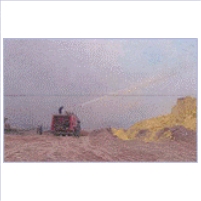Iraq War Soldiers Returned with Lung Disease Caused by Sulfur Mine Fire
Thursday, April 29, 2010

American soldiers exposed in 2003 to smoke from the burning Mishraq Sulfur Mine in northern Iraq have developed serious lung disorders not identifiable using x-rays or CT scans. In June 2003, Iraqi forces opposing the U.S. invasion set fire to the mine, which, at the time, was the world’s largest sulfur mine. The fire burned for four weeks, releasing 42 million pounds of sulfur dioxide a day. Members of the 101st Airborne from Fort Campbell were exposed to the toxic gas.
Dr. Robert Miller, Associate Professor of Pulmonary and Critical Care Medicine
at Vanderbilt University Medical Center, has found the only way to diagnosis the illnesses is to perform lung biopsies.
at Vanderbilt University Medical Center, has found the only way to diagnosis the illnesses is to perform lung biopsies.
Out of 80 military personnel examined, Miller found 34 were suffering from constrictive bronchiolitis, sarcoidosis, respiratory bronchiolitis, respiratory bronchiolisitis with interstitial lung disease or hypersensitivity pneumonitis. Many of these conditions are irreversible and untreatable.
-Noel Brinkerhoff, David Wallechinsky
Soldiers Return with Mystery Lung Disease (by Jake Lowary, Leaf Chronicle)
Statement of Robert F. Miller, M.D. (Senate Committee on Veterans Affairs)
Fire at Iraqi Sulfur Plant Emits SO2 Clouds Detected by Earth Probe TOMS (by Carn, Krueger, Krotlov and Gray. Geophysical Research Letters) (pdf)
- Top Stories
- Unusual News
- Where is the Money Going?
- Controversies
- U.S. and the World
- Appointments and Resignations
- Latest News
- Trump to Stop Deportations If…
- Trump Denounces World Series
- What If China Invaded the United States?
- Donald Trump Has a Mental Health Problem and It Has a Name
- Trump Goes on Renaming Frenzy






Comments